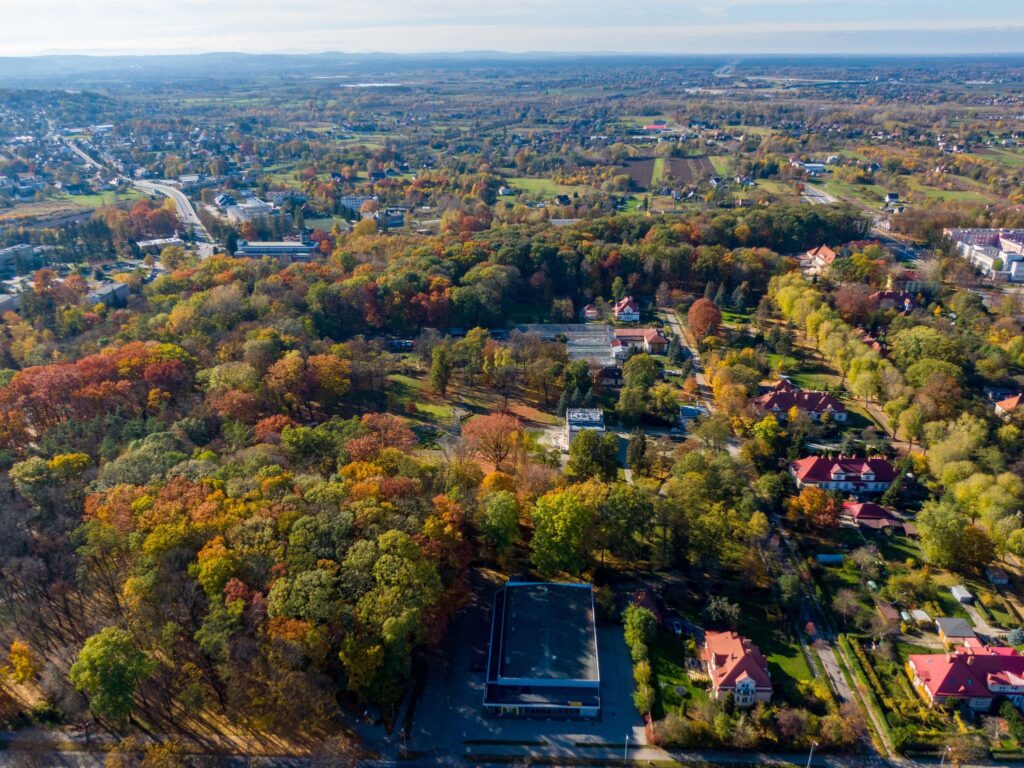Mościce
In the western part of Tarnów, between the Biała and Dunajec rivers are Mościce, a district with distinctive housing estates for National Factory of Nitric Compounds workers, entirely different from other parts of the city. It was established at the end of the 1920s, in the place of two villages-Dąbrówka Infułacka and Świerczków, south of the newly built factory. The factory was the largest investment in the Second Polish Republic after the construction of the port and the city of Gdynia. On an area of about 200 ha, 12 villas with modernist features, stylized as landowners’ seats from the 19th century were built, as well as a presentable villa with a vast park for the CEO of the factory, designed by Konrad Kłos, located at Jarzębinowa 9. Four-storey multi-family buildings were constructed for officials and highly qualified workers. The labourers and their families lived in wooden barracks. The designers’ idea was to create a garden-housing estate. The designated streets were named after the type of tree they were planted with. In honour of president Ignacy Mościcki, they were called Mościce. In 1934, the “Za torem” estate with modernist villas was erected in the northern part of Mościce. In 1951, Mościce was incorporated into the city. In 1979, the establishment was entered in the register of monuments. In the 1970s and 1980s, Mościce was enriched with a modern cultural and sports infrastructure, including the Company Cultural Center (currently the Mościce Art Center) and the Jaskółka sports hall. The latter was replaced in 2019 by a larger facility with interesting modern architecture.
Click to listen highlighted text! In the western part of Tarnów, between the Biała and Dunajec rivers are Mościce, a district with distinctive housing estates for National Factory of Nitric Compounds workers, entirely different from other parts of the city. It was established at the end of the 1920s, in the place of two villages-Dąbrówka Infułacka and Świerczków, south of the newly built factory. The factory was the largest investment in the Second Polish Republic after the construction of the port and the city of Gdynia. On an area of about 200 ha, 12 villas with modernist features, stylized as landowners’ seats from the 19th century were built, as well as a presentable villa with a vast park for the CEO of the factory, designed by Konrad Kłos, located at Jarzębinowa 9. Four-storey multi-family buildings were constructed for officials and highly qualified workers. The labourers and their families lived in wooden barracks. The designers’ idea was to create a garden-housing estate. The designated streets were named after the type of tree they were planted with. In honour of president Ignacy Mościcki, they were called Mościce. In 1934, the “Za torem” estate with modernist villas was erected in the northern part of Mościce. In 1951, Mościce was incorporated into the city. In 1979, the establishment was entered in the register of monuments. In the 1970s and 1980s, Mościce was enriched with a modern cultural and sports infrastructure, including the Company Cultural Center (currently the Mościce Art Center) and the Jaskółka sports hall. The latter was replaced in 2019 by a larger facility with interesting modern architecture.In the western part of Tarnów, between the Biała and Dunajec rivers are Mościce, a district with distinctive housing estates for National Factory of Nitric Compounds workers, entirely different from other parts of the city. It was established at the end of the 1920s, in the place of two villages-Dąbrówka Infułacka and Świerczków, south of the newly built factory. The factory was the largest investment in the Second Polish Republic after the construction of the port and the city of Gdynia. On an area of about 200 ha, 12 villas with modernist features, stylized as landowners’ seats from the 19th century were built, as well as a presentable villa with a vast park for the CEO of the factory, designed by Konrad Kłos, located at Jarzębinowa 9. Four-storey multi-family buildings were constructed for officials and highly qualified workers. The labourers and their families lived in wooden barracks. The designers’ idea was to create a garden-housing estate. The designated streets were named after the type of tree they were planted with. In honour of president Ignacy Mościcki, they were called Mościce. In 1934, the “Za torem” estate with modernist villas was erected in the northern part of Mościce. In 1951, Mościce was incorporated into the city. In 1979, the establishment was entered in the register of monuments. In the 1970s and 1980s, Mościce was enriched with a modern cultural and sports infrastructure, including the Company Cultural Center (currently the Mościce Art Center) and the Jaskółka sports hall. The latter was replaced in 2019 by a larger facility with interesting modern architecture.



